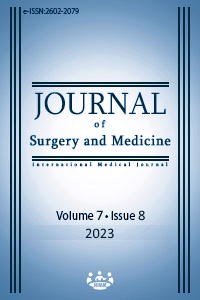The prognostic effect of lymphocyte, monocyte, and platelet counts, mean platelet volume, neutrophil-to-lymphocyte ratio, lymphocyte-to-monocyte ratio, and platelet-to-lymphocyte ratio on different stages of pressure ulcers
Hematological parameters and pressure ulcer stage
Keywords:
pressure ulcer, pressure ulcer stage, hematological parameters, intensive care unitAbstract
Background/Aim: Pressure ulcers (PU) pose a significant problem for patients in intensive care. Various factors contribute to the development of pressure sores. The primary focus of treatment is to implement measures that prevent factors such as nutrition and positioning, which can lead to PUs. Therefore, it is crucial to identify parameters that can serve as warning signals for the formation and progression of PU. This study investigates the potential use of hematological parameters as warning signals.
Methods: Demographic data, co-morbidities, PU stages, and laboratory parameters of 158 patients hospitalized in the intensive care unit who developed pressure ulcers during their hospital stay were recorded and analyzed.
Results: Among the 158 cases included in the study, PUs were more prevalent in patients of advanced age, those with pneumonia, chronic obstructive pulmonary disease (COPD), coronary diseases, and neurodegenerative diseases. Mean platelet volume (MPV) was significantly higher in PU stages 2 and 3 compared to stage 1. However, age, lymphocyte count, monocyte count, neutrophil-to-lymphocyte ratio (NLR), lymphocyte-to-monocyte ratio (LMR), and platelet-to-lymphocyte ratio (PLR) did not exhibit significant differences among the stages of PU (P<0.05).
Conclusion: Advanced age, pneumonia, COPD, coronary diseases, and neurodegenerative diseases are identified as risk factors for PU. Although MPV was initially considered a potential, stimulating parameter, the evidence was insufficient. Further research is required to explore this issue. The impact of parameters other than MPV did not show any excitatory signal in this study.
Downloads
References
Firat Kiliç H, Sucudag G. The scales frequently used in patients with the Assessment of Pressure Sores. G.O.P. Taksim E.A.H. JAREN. 2017;3(1):49-54. DOI: https://doi.org/10.5222/jaren.2017.049
Jaul E, Barron J, Rosenzweig JP, Menczel J. An overview of co-morbidities and the development of pressure ulcers among older adults. BMC Geriatr. 2018;18(1):305. DOI: https://doi.org/10.1186/s12877-018-0997-7
Adıyeke E, Adıyeke L. Neutrophil to lymphocyte ratio and mean platelet volume may predict the development of the pressure ulcers. J Surg Med. 2020;4(7):578-81. DOI: https://doi.org/10.28982/josam.739227
Shi C, Dumville JC, Cullum N. Support surfaces for pressure ulcer prevention: A network meta-analysis. Plos One. 2018;13(2):e0192707. DOI: https://doi.org/10.1371/journal.pone.0192707
Dincer M, Doger C, Tas SS, Karakaya D. An analysis of patients in palliative care with pressure injuries. Niger J Clin Pract. 2018;21:484-91. DOI: https://doi.org/10.4103/njcp.njcp_51_17
Manzano F, Perez-Perez AM, Martinez-Ruiz S, Garrido-Colmenero C, Roldan D, Jiménez-Quintana Mdel M, et al. Hospital-acquired pressure ulcers and risk of hospital mortality in intensive care patients on mechanical ventilation. J Eval Clin Pract. 2014;20:362-8. DOI: https://doi.org/10.1111/jep.12137
Labeau SO, Afonso E, Benbenishty J, Blackwood B, Boulanger C, Brett SJ, et al. Prevalence, associated factors and outcomes of pressure injuries in adult intensive care unit patients: the DecubICUs study. Intensive Care Med. 2021;47(2):160-9. DOI: https://doi.org/10.1007/s00134-020-06327-5
Kaitani T, Tokunaga K, Matsui N, Sanada H. Risk factors related to the development of pressure ulcers in the critical care setting. J Clin Nurs. 2010;19(3–4):414–21. DOI: https://doi.org/10.1111/j.1365-2702.2009.03047.x
Cox J. Pressure Injury Risk Factors in Adult Critical Care Patients: A Review of the Literature. Ostomy Wound Manage. 2017;63(11):30–43.
Aloweni F, Ang SY, Fook-Chong S, Agus N, Yong P, Goh MM, et al. A prediction tool for hospital-acquired pressure ulcers among surgical patients: Surgical pressure ulcer risk score. Int Wound J. 2019;16(1):164-75. DOI: https://doi.org/10.1111/iwj.13007
Lopatina T, Bruno S, Tetta C, Kalinina N, Porta M, Camussi G. Platelet-derived growth factor regulates the secretion of extracellular vesicles by adipose mesenchymal stem cells and enhances their angiogenic potential. Cell Communication and Signaling. 2014;12(1):26–38. DOI: https://doi.org/10.1186/1478-811X-12-26
Korniluk A, Koper-Lenkiewicz OM, Kamińska J, Kemona H, Dymicka-Piekarska V. Mean Platelet Volume (MPV): New Perspectives for an Old Marker in the Course and Prognosis of Inflammatory Conditions. Mediators Inflamm. 2019;17;2019:9213074. DOI: https://doi.org/10.1155/2019/9213074
Koca Kutlu A, Diramalı A, Temiz C, Onur E, Miskioğlu M. Effect of exercise on blood values and vital findings in bed-connected patients. Journal Of Ege University Faculty of Nursing. 2011;27(1):25-36.
Erben Durmusoglu S, Kiliç F, Unsal M, Aytekin O, Kimyon Comert G, Karalok A, et al. Preoperative neutrophil/lymphocyte, lymphocyte/monocyte and platelet/lymphocyte ratios serous ovarian cancer survival Balikesir Medical Journal. 2021;5(1):43-53. DOI: https://doi.org/10.33716/bmedj.871929
Dede S. In Critical Patients Diagnosed Wıth Covid-19, Platelet Lymphocyte Rate, Monocyte Lymphocyte Rate And Some Others Effect Of Hematological Values On Prognosis. (Master thesis in medicine), Konya, Necmettin Erbakan University 2021.
Downloads
- 420 582
Published
Issue
Section
How to Cite
License
Copyright (c) 2023 Leman Acun Delen, Mesut Öterkuş
This work is licensed under a Creative Commons Attribution-NonCommercial-NoDerivatives 4.0 International License.
















